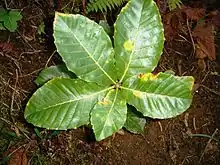Quercus pontica
Quercus pontica, the Pontine oak or Armenian oak,[1] is a species of oak native to the western Caucasus mountains of Georgia and northeastern Turkey and Armenia, where it grows at altitudes of 1,300-2,100 m.
| Quercus pontica | |
|---|---|
 | |
| Scientific classification | |
| Kingdom: | Plantae |
| Clade: | Tracheophytes |
| Clade: | Angiosperms |
| Clade: | Eudicots |
| Clade: | Rosids |
| Order: | Fagales |
| Family: | Fagaceae |
| Genus: | Quercus |
| Subgenus: | Quercus subg. Quercus |
| Section: | Quercus sect. Mesobalanus |
| Species: | Q. pontica |
| Binomial name | |
| Quercus pontica | |
Description
Quercus pontica is a deciduous small tree or large shrub growing to 6–10 m tall, with a trunk up to 40 cm diameter and sparse, stout shoots. Its bark is grayish to purple-brown, smooth on young trees but becoming rough later in its life. Its leaves grow to 10–20 cm long (rarely 35 cm) and 4–15 cm across, ovate, with a serrated margin with numerous small, pointed teeth. The leaves are covered in hairs when they are young, but become smoother as they age. They become bright green later in life and turn yellow brown in autumn. The flowers are catkins, the male catkins 5–20 cm long. The fruit is a large acorn 2.5–4 cm long, produced in clusters of 2-5 together.
Taxonomy
The specific epithet pontica, refers to the Latin term for Pontus, a historical region near the Black Sea.[2]
Cultivation
It is occasionally grown as an ornamental tree in northern Europe.
References
- David More, John White, The Illustrated Encyclopedia of Trees, (Timber Press Inc., 2002), 379.
- Archibald William Smith A Gardener's Handbook of Plant Names: Their Meanings and Origins, p. 280, at Google Books
External links
Other sources
- Rushforth, K. D. Trees of Britain and Europe. Collins.
- Coombes, A. J. Trees. Eyewitness Handbooks.